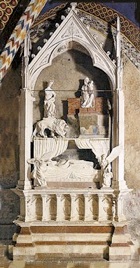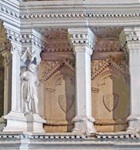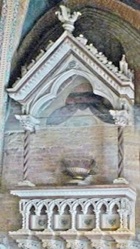This monument in the entrance narthex of the Lower Church covers and therefore post-dates the original frescoes (13th century) on the wall behind it. It has been reconstituted and might well have been moved from another location: indeed, it could contain elements of more than one original.
The monument has been attributed to Ramo di Paganello and/or Rubeus. If this is correct, it was probably executed:
-
✴in the period 1302-10, when Ramo di Paganello was capomaestro at Orvieto and Rubeus apparently worked under him; or
-
✴in the subsequent period, when Ramo di Paganello was at the Angevin court at Naples.
At the centre of the monument, angels draw back (or perhaps close) drapes in front of an effigy lying in a funerary chamber. This motif almost certainly derives from the monument (ca. 1282) to Cardinal Guillaume de Bray in San Domenico, Orvieto, which is the earliest surviving signed work by Arnolfo di Cambio. The space above the effigy is occupied by two figures:
-
✴a crowned figure sitting on a faldstool stool that rests on the back of a lion; and
-
✴a figure of the Madonna and Child enthroned, to the right.
In its present arrangement, the monument is housed in a Gothic aedicule, the base of which contains:
-
✴six small figures of saints (two at each end and two at the front, one of which is illustrated here); and
-
✴reliefs of a coat of arms that have been identified as those of Philip of Courtenay, who was titular Emperor of Constantinople in 1273-83.
Identity of the Deceased
The monument contains two images that presumably represent the deceased:
-
✴the effigy; and
-
✴the figure sitting on a faldstool stool above.
Each of these figures is crowned and could represent a man or a woman. The effigy has been shortened and its lower part has been abraded, which adds to the problem of identification.
The monument was first documented in 1418 as the tomb of the Emperor of Constantinople. This is often said to be a reference to John of Brienne, who was King of Jerusalem in 1210-25 and Emperor of Constantinople in 1231-7. He probably met St Francis at Damietta in 1219-20, during the Fifth Crusade, and he attended the canonisation in Assisi in 1228. In his "De Conformitate Vitae Beati Francisci ad Vitam Domini Iesu" (ca. 1385), Fr Bartholomew of Pisa recorded that he became a Franciscan tertiary before he died and that he was buried at Assisi. However,
-
✴a document of 1488 records the tomb as the “sepulcrum Imperatricis Costantinopolitanae” (i.e. of the Empress of Constantinople); and
-
✴in a list of the tombs in San Francesco in 1509, the sacristan Galeotto recorded:
-
•the tomb (in an unspecified location) of John of Brienne and of his daughter, Yolande (Isabella), who was the wife of the Emperor Frederick II and, in her own right, Queen of Jerusalem (1212-28); and
-
•the tomb, in the middle of the church, in front of the door, of an unspecified Queen of Cyprus, who had given a large amount of money to the friars, as well as a vase for holy water.
Our monument was subsequently described as the tomb of a Queen of Cyprus by:
-
✴Giorgio Vasari (in 1568), who attributed it to the otherwise unknown Fuccio Fiorentino (in his account of the lives of Nicolò and Giovanni Pisano); and
-
✴ Fr. Ludovico Pietralunga (in ca. 1575), who referred to the otherwise unknown Queen Eugubea (Hecuba).
As noted above, the arms on the monument have been identified as those of Philip of Courtenay, the grandson of John of Brienne, who was titular Emperor of Constantinople in 1273-83, and he must also be considered as a candidate.
To make further headway, it is necessary to summarise the relevant history of Latin Constantinople and of Cyprus.
Possible Emperors of Constantinople
The Latin Empire of Constantinople was established when the leaders the Fourth Crusade (1204) captured the Byzantine Empire. The Latin Emperor Baldwin II of Courtenay succeeded to the throne in 1228, when he was only 11 years old. The territory faced invasion and the barons invited John of Brienne to act as regent. He agreed on condition that Baldwin II should marry his daughter (from his third marriage), Marie. The imperial marriage took place in 1234, when Marie was about 9 years old and Baldwin II was 17. John of Brienne died in Constantinople in 1237.
The empire that Baldwin II ruled, which was little more that the city of Constantinople, fell to the Byzantine Emperor Michael VIII Palaeologus in 1261. Baldwin II, Marie and their young son, Philip of Courtenay fled to the court of King Manfred of Sicily. When Manfred died in 1266 in the battle that brought Charles d’ Anjou to the throne, Baldwin II came to an arrangement with the victor: he sold his rights over lands along the Adriatic coast and over Corfu to Charles d’ Anjou, and Philip de Courtenay was married to Charles’ daughter, Beatrice of Sicily. Charles d’ Anjou agreed to support a campaign to retake Constantinople and to place Philip and Beatrice on the imperial throne, on the understanding that, if they died childless, the title would revert to him or to his heirs.
The marriage took place in 1273, a few days before Baldwin II died. Marie (now dowager Empress) and Philip and Beatrice (now titular Emperor and Empress) spent the rest of their lives in the court of Naples:
-
✴Beatrice died in 1275;
-
✴Marie died in ca. 1275;
-
✴Philip died in 1283 (a year after a planned campaign to re-take Constantinople had been aborted).
Catherine I of Courtenay, the daughter of Philip and Beatrice, was then titular Empress of Constantinople from 1283 to her death in 1307.
This monument could commemorate any or all of these figures). Marie could have brought part of the body of her father, John of Brienne with her to Italy, and it could also have been buried here. It is unlikely that the tomb at Assisi ever contained the remains of John’s other daughter, Yolande, who was buried in the Duomo, Andria (near Bari), alongside Isabella of England, the third wife her husband, the Emperor Frederick II.
Possible Queens of Cyprus
Ludovico da Pietralunga gives some information about the lady that he named as Queen Eugubea of Cyprus, who had apparently been cured of an illness after praying to St Francis. The vase that she subsequently sent to San Francesco (mentioned also by the sacristan Galeotto in 1509) was made of porphyry and served as a vessel for holy water near the entrance to the lower church. This is almost certainly the vase that now stands in the monument of the Cerchi family in the
narthex of the lower church (to the right of the monument described here).
There is in fact a strong link between Cyprus and the Franciscans:
-
✴St Francis may well have had landed in Cyprus in 1219 en route for the East, and the Franciscan community on the island dates from that time.
-
✴When Acre fell to the Moslems in 1291, Cyprus became the centre of Franciscan operations in the East. By that time there were five convents on the island.
There are two possible candidates for “Queen Eugubea”:
-
✴Queen Isabella I of Ibelin, the wife of King Hugh II of Cyprus, died in 1282. However, Hugh II had died in 1267: she went on to marry again on three occasions, and she probably no longer used her title from her first marriage by the time that she died. She had a racy reputation, and there is no reason to think that she was ever close to the Franciscans.
-
✴Queen Isabella II of Ibelin, the wife of King Hugh III of Cyprus, died in 1324 and was buried in the Franciscan church of Nicosia. She was still dowager Queen of Cyprus when she died, despite the fact that Hugh III had died in 1284. It is possible that part of her body was interred at Assisi, but that must have been some decades after the monument under discussion was built.
Silvestro Nessi (see below) confused King Hugh II of Cyprus with Hugh of Brienne, who served in the Angevin navy and was killed in battle off Sicily in 1296. He also confused their respective wives: Isabella I of Ibelin and Isabella de la Roche. He also thought that Isabella I of Ibelin had died in 1267, which was the year in which she ceased to by Queen of Cyprus. He considered her to be “the only queen of Cyprus who could be characterised as the mythical benefactress” of the basilica.
Precedents
[When King Louis IX died in the crusade off Tunis, his son (now King Philip III), who had been with him, returned to the Angevin court at Naples, en route for France. Isabella of Aragon, the wife of Philip III, died in Cosenza in 1271: while Philip took her body back to Paris, her heart was buried in a tomb (1271), fragments of which survive in the Duomo, Cosenza. Is there any stylistic link ???]
[Amicie de Courtenay died in Rome in 1275 and was apparently buried in Old St Peter’s. Relationship? She died in the same year as Marie and Beatrice]
[The statue (1277) of Charles d’ Anjou as senator of Rome (now in the Musei Capitolini, Rome), which he commissioned from Arnolfo di Cambio. This figure is seated on a throne, the arms of which are in the form of lions. Is this an important link to the iconography of a king enthroned on a lion ???]
[Marie de Coucy, the daughter-in-law of John of Brienne, died (apparently in France) in 1285. She had been Queen of Scotland in (1239-49), and was buried in Newbattle Abbey, Scotland. In the 19th century, Father Richard Augustin Hay recorded that her effigy lay on a marble sarcophagus that was supported on six marble lions.]
Read more:
E. Lunghi, “Rubeus me Fecit”: Scultura in Umbria alla Fine del Duecento”, Studi di Storia dell’ Arte, 2 (1991) 9-32
G. Kreytenberg, “La Tomba dell’ Imperatore Latino di Costantinopoli”, Studi di Storia dell’ Arte, 8 (1997) 9-48
S. Nessi, “La Basilica di S. Francesco in Assisi e la sua Documentazione Storica”, (1982), Assisi (p 392)
Return to the Lower Church.
Return to the main page on San Francesco.
Return to Walk III.
Return to the home page on Assisi.






